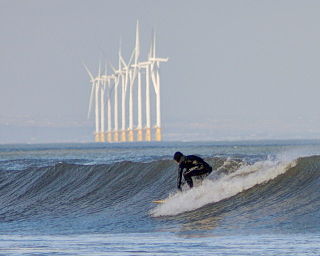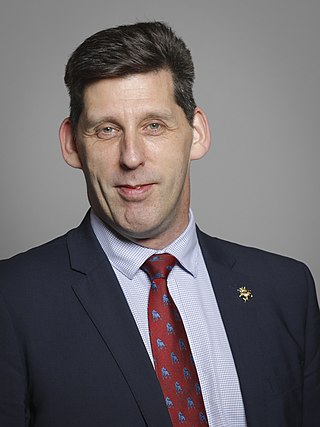
A wind farm or wind park, also called a wind power station or wind power plant, is a group of wind turbines in the same location used to produce electricity. Wind farms vary in size from a small number of turbines to several hundred wind turbines covering an extensive area. Wind farms can be either onshore or offshore.

William John Graham Scott is a Scottish farmer and former Scottish Conservative politician. He was the Member of the Scottish Parliament (MSP) for Ayr from 2000 to 2021.

Ballantrae is a community in Carrick, South Ayrshire, Scotland. The name probably comes from the Scottish Gaelic Baile na Tràgha, meaning the 'town by the beach'. Ballantrae has a primary school. The beach consists of shingle and sand and offers views of Ailsa Craig, the Isle of Arran and Kintyre.

The United Kingdom is the best location for wind power in Europe and one of the best in the world. The combination of long coastline, shallow water and strong winds make offshore wind unusually effective.
The Thanet Wind Farm is an offshore wind farm 7 miles (11 km) off the coast of Thanet district in Kent, England. On commissioning it was the world's largest offshore wind farm. It has a nameplate capacity of 300 MW and it cost £780–900 million (US$1.2–1.4 billion). Thanet is one of fifteen Round 2 wind projects announced by the Crown Estate in January 2004 but the first to be developed. It was officially opened on 23 September 2010, when it overtook Horns Rev 2 as the biggest offshore wind farm in the world. It has since been overtaken by many others.

The production of renewable energy in Scotland is a topic that came to the fore in technical, economic, and political terms during the opening years of the 21st century. The natural resource base for renewable energy is high by European, and even global standards, with the most important potential sources being wind, wave, and tide. Renewables generate almost all of Scotland's electricity, mostly from the country's wind power.

Greater Gabbard is a 504 MW wind farm, built on sandbanks 23 kilometres (14 mi) off the coast of Suffolk in England at a cost of £1.5 billion. It was completed on 7 September 2012 with all of the Siemens SWT3.6–107 turbines connected. Developed as a joint venture between Airtricity and Fluor, it is now jointly owned by SSE Renewables and RWE.

Wind power generation capacity in India has significantly increased in recent years. As of 31 March 2024, the total installed wind power capacity was 45.887 gigawatts (GW). India has the fourth largest installed wind power capacity in the world. Wind power capacity is mainly spread across the southern, western, and northwestern states. The onshore wind power potential of India was assessed at 132 GW with minimum 32% CUF at 120 m above the local ground level.

Wind power is the fastest-growing renewable energy technology in Scotland, with 11,482 megawatts (MW) of installed wind power capacity by Q1 2023. This included 9,316 MW from onshore wind in Scotland and 2,166 MW of offshore wind generators.

A floating wind turbine is an offshore wind turbine mounted on a floating structure that allows the turbine to generate electricity in water depths where fixed-foundation turbines are not feasible. Floating wind farms have the potential to significantly increase the sea area available for offshore wind farms, especially in countries with limited shallow waters, such as Spain, Portugal, Japan, France and the United States' West Coast. Locating wind farms further offshore can also reduce visual pollution, provide better accommodation for fishing and shipping lanes, and reach stronger and more consistent winds.

West of Duddon Sands Wind Farm (WoDS), occasionally also known as West Duddon Wind Farm is an offshore wind farm located 14 kilometres (8.7 mi) south west of Walney Island off the coast of Barrow-in-Furness in Cumbria, in the Irish Sea, England. It was developed by Scottish Power and Ørsted A/S.

Walney Wind Farms are a group of offshore wind farms 9 miles (14 km) west of Walney Island off the coast of Cumbria, England, in the Irish Sea. The group, operated by Ørsted, consists of Walney Phase 1, Phase 2 and the Walney Extension. The extension has a capacity of 659 MW and it was the world's second largest offshore wind farm in 2018.

Teesside Wind Farm, or alternatively referred to as Redcar Wind Farm, is a 27 turbine 62 MW capacity offshore wind farm constructed just to the east of the mouth of the River Tees and 1.5 km north of Redcar off the North Yorkshire coast, in the North Sea, England.
The Beatrice Oil Field is a small oilfield consisting of 3 platforms located 24 km off the north east coast of Scotland. It began operations in 1980 with the field finally being decommissioned in 2017.

Ian James Duncan, Baron Duncan of Springbank is a Scottish politician serving as a deputy speaker in the House of Lords. A member of the Conservative Party, he was formerly Minister for Climate Change in the Department for Business, Energy and Industrial Strategy and minister in the Northern Ireland Office. He initially joined the UK Government as a Scotland Office minister following the 2017 UK general election. Duncan was a Member of the European Parliament (MEP) for Scotland from 2014 to 2017. He is the only minister to have served in each of the UK Government's territorial offices.
Dogger Bank Wind Farm is a group of offshore wind farms under construction 130 to 200 kilometres off the east coast of Yorkshire, England in the North Sea. It is considered to be the world's largest offshore windfarm. It was developed by the Forewind consortium, with three phases envisioned - first phase, second phase and third phase. In 2015, the third phase was abandoned, while the first and second phases were granted consent. It was initially expected that the Dogger Bank development will consist of four offshore wind farms, each with a capacity of up to 1.2 GW, creating a combined capacity of 4.8 GW. As of 2023, a total of 277 turbines are expected to be built and produce a capacity of 3.6 GW, enough to power 6 million homes.
The European Offshore Wind Deployment Centre (EOWDC), also known as the Aberdeen Bay Wind Farm is an offshore wind test and demonstration facility located around 3 kilometres off the east coast of Aberdeenshire, in the North Sea, Scotland. It was developed by the European Offshore Wind Deployment Centre consortium. The scheme is relatively small - it consists of 11 wind turbines with an installed capacity of 93.2 megawatts. It is located between Blackdog and Bridge of Don near Aberdeen. First power was generated in July 2018, with full commissioning following in September 2018.

The East Anglia Array is a proposed series of offshore wind farms located around 30 miles off the east coast of East Anglia, in the North Sea, England. It has begun with the currently operational East Anglia ONE, that has been developed in partnership by ScottishPower Renewables and Vattenfall. Up to six individual projects could be set up in the area with a maximum capacity of up to 7.2 GW. The first project, East Anglia ONE at 714 MW, received planning consent in June 2014 and contracts in April 2016. Offshore construction began in 2018 and the project was commissioned in July 2020. It is expected to cost £2.5 billion.

Trump International Golf Club Scotland Ltd v Scotland [2015] UKSC 74 is a 2015 judgment of the Supreme Court of the United Kingdom on the authority of the Scottish government to allow windfarm applications, under the Electricity Act 1989. It is relevant for UK enterprise law and the regulation of UK wind power.














